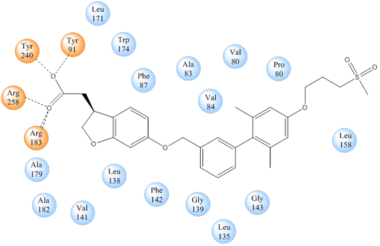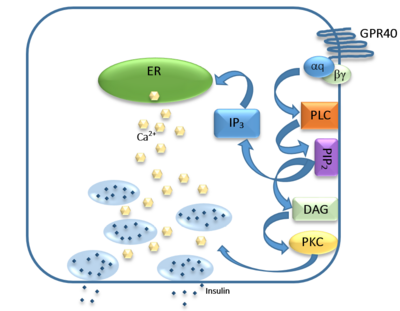User:Brittany Stankavich/Sandbox 1
From Proteopedia
(Difference between revisions)
| Line 29: | Line 29: | ||
FFAs bind to hGPR40 by coordinating its free carboxyl group to three amino acids, <scene name='72/727085/Ffa_binding/1'>Arg183, Tyr2240, and Arg258</scene>, which are located close to the <scene name='72/727085/Hgpr40_transmane_active/1'>extracellular domain</scene> of hGPR40 on TM5, 6 and 7. Because of the close proximity of these residues to the extracellular domain and the dominantly hydrophobic nature of FFA’s, it is possible that ligand binding occurs close to, or within, the plane of the membrane <ref name="Morg">PMID:19660440</ref>. | FFAs bind to hGPR40 by coordinating its free carboxyl group to three amino acids, <scene name='72/727085/Ffa_binding/1'>Arg183, Tyr2240, and Arg258</scene>, which are located close to the <scene name='72/727085/Hgpr40_transmane_active/1'>extracellular domain</scene> of hGPR40 on TM5, 6 and 7. Because of the close proximity of these residues to the extracellular domain and the dominantly hydrophobic nature of FFA’s, it is possible that ligand binding occurs close to, or within, the plane of the membrane <ref name="Morg">PMID:19660440</ref>. | ||
| - | === | + | === [http://proteopedia.org/wiki/index.php/Image:Tak_875.png TAK-875] === |
| - | + | ||
| - | + | ||
'''Tak-875''' is known to be a [https://en.wikipedia.org/wiki/Partial_agonist partial agonist] of GPR40. The binding of TAK-875 to the binding site is fairly unique, as it is proposed that the ligand must enter through the [https://en.wikipedia.org/wiki/Cell_membrane membrane bilayer]. This is performed via a method similar to ligand binding to sphingosine 1-phosphate receptor 1 [[:3v2w]], retinal loading of opsin [[:4j4q]] and the entry of anandamide in [https://en.wikipedia.org/wiki/Cannabinoid_receptor cannabinoid receptors], in which <scene name='72/727085/Hgpr40_a/6'>extracellular loops</scene> block the binding from the extracellular matrix <ref>PMID:22344443</ref>. In contrast, delta opioid receptor binding [[:4ej4]] allow for binding directly from the [https://en.wikipedia.org/wiki/Extracellular_matrix extracellular matrix]. The binding mechanism through the bilayer may be selectively favoring the free fatty acid because of the [https://en.wikipedia.org/wiki/Chemical_polarity#Nonpolar_molecules non-polar] regions of the ligand. | '''Tak-875''' is known to be a [https://en.wikipedia.org/wiki/Partial_agonist partial agonist] of GPR40. The binding of TAK-875 to the binding site is fairly unique, as it is proposed that the ligand must enter through the [https://en.wikipedia.org/wiki/Cell_membrane membrane bilayer]. This is performed via a method similar to ligand binding to sphingosine 1-phosphate receptor 1 [[:3v2w]], retinal loading of opsin [[:4j4q]] and the entry of anandamide in [https://en.wikipedia.org/wiki/Cannabinoid_receptor cannabinoid receptors], in which <scene name='72/727085/Hgpr40_a/6'>extracellular loops</scene> block the binding from the extracellular matrix <ref>PMID:22344443</ref>. In contrast, delta opioid receptor binding [[:4ej4]] allow for binding directly from the [https://en.wikipedia.org/wiki/Extracellular_matrix extracellular matrix]. The binding mechanism through the bilayer may be selectively favoring the free fatty acid because of the [https://en.wikipedia.org/wiki/Chemical_polarity#Nonpolar_molecules non-polar] regions of the ligand. | ||
Revision as of 13:46, 21 April 2016
- User:Brittany Stankavich/Sandbox 1
hGPR40 Homo sapiens
| |||||||||||
References
- ↑ 1.00 1.01 1.02 1.03 1.04 1.05 1.06 1.07 1.08 1.09 1.10 Srivastava A, Yano J, Hirozane Y, Kefala G, Gruswitz F, Snell G, Lane W, Ivetac A, Aertgeerts K, Nguyen J, Jennings A, Okada K. High-resolution structure of the human GPR40 receptor bound to allosteric agonist TAK-875. Nature. 2014 Jul 20. doi: 10.1038/nature13494. PMID:25043059 doi:http://dx.doi.org/10.1038/nature13494
- ↑ Ren XM, Cao LY, Zhang J, Qin WP, Yang Y, Wan B, Guo LH. Investigation of the Binding Interaction of Fatty Acids with Human G Protein-Coupled Receptor 40 Using a Site-Specific Fluorescence Probe by Flow Cytometry. Biochemistry. 2016 Mar 17. PMID:26974599 doi:http://dx.doi.org/10.1021/acs.biochem.6b00079
- ↑ 3.0 3.1 3.2 3.3 3.4 Ichimura A, Hirasawa A, Hara T, Tsujimoto G. Free fatty acid receptors act as nutrient sensors to regulate energy homeostasis. Prostaglandins Other Lipid Mediat. 2009 Sep;89(3-4):82-8. doi:, 10.1016/j.prostaglandins.2009.05.003. Epub 2009 May 19. PMID:19460454 doi:http://dx.doi.org/10.1016/j.prostaglandins.2009.05.003
- ↑ 4.0 4.1 4.2 4.3 4.4 4.5 4.6 4.7 4.8 Morgan NG, Dhayal S. G-protein coupled receptors mediating long chain fatty acid signalling in the pancreatic beta-cell. Biochem Pharmacol. 2009 Dec 15;78(12):1419-27. doi: 10.1016/j.bcp.2009.07.020., Epub 2009 Aug 4. PMID:19660440 doi:http://dx.doi.org/10.1016/j.bcp.2009.07.020
- ↑ Ren XM, Cao LY, Zhang J, Qin WP, Yang Y, Wan B, Guo LH. Investigation of the Binding Interaction of Fatty Acids with Human G Protein-Coupled Receptor 40 Using a Site-Specific Fluorescence Probe by Flow Cytometry. Biochemistry. 2016 Mar 17. PMID:26974599 doi:http://dx.doi.org/10.1021/acs.biochem.6b00079
- ↑ Hanson MA, Roth CB, Jo E, Griffith MT, Scott FL, Reinhart G, Desale H, Clemons B, Cahalan SM, Schuerer SC, Sanna MG, Han GW, Kuhn P, Rosen H, Stevens RC. Crystal structure of a lipid G protein-coupled receptor. Science. 2012 Feb 17;335(6070):851-5. PMID:22344443 doi:10.1126/science.1215904
- ↑ Li X, Zhong K, Guo Z, Zhong D, Chen X. Fasiglifam (TAK-875) Inhibits Hepatobiliary Transporters: A Possible Factor Contributing to Fasiglifam-Induced Liver Injury. Drug Metab Dispos. 2015 Nov;43(11):1751-9. doi: 10.1124/dmd.115.064121. Epub 2015, Aug 14. PMID:26276582 doi:http://dx.doi.org/10.1124/dmd.115.064121
- ↑ 8.0 8.1 Takano R, Yoshida M, Inoue M, Honda T, Nakashima R, Matsumoto K, Yano T, Ogata T, Watanabe N, Hirouchi M, Yoneyama T, Ito S, Toda N. Discovery of DS-1558: A Potent and Orally Bioavailable GPR40 Agonist. ACS Med Chem Lett. 2015 Jan 13;6(3):266-70. doi: 10.1021/ml500391n. eCollection, 2015 Mar 12. PMID:25815144 doi:http://dx.doi.org/10.1021/ml500391n


